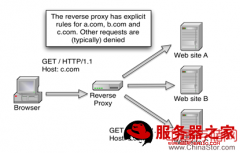本文介绍Apache/Nginx性能调优相关工作原理,希望对于初学Nginx服务器相关的朋友有帮助,更多Nginx安装、配置、报错处理等资源请本站内搜索。。
正确使用Etag和Expires标识处理,可以使得页面更加有效被Cache。
在客户端通过浏览器发出第一次请求某一个URL时,根据 HTTP 协议的规定,浏览器会向服务器传送报头(Http Request Header),服务器端响应同时记录相关属性标记(Http Reponse Header),服务器端的返回状态会是200,格式类似如下:
HTTP/1.1 200 OK
Date: Tue, 03 Mar 2009 04:58:40 GMT
Content-Type: image/jpeg
Content-Length: 83185
Last-Modified: Mon, 22 Nov 2010 16:29:24 GMT
Cache-Control: max-age=2592000
Expires: Thu, 02 Apr 2009 05:14:08 GMT Etag: "xok.la-961AA72-4CEA99B4415628″客户端第二次请求此URL时,根据 HTTP 协议的规定,浏览器会向服务器传送报头(Http Request Header),服务器端响应并记录相关记录属性标记文件没有发生改动,服务器端返回304,直接从缓存中读取:
HTTP/1.x 304 Not Modified
Date: Tue, 03 Mar 2009 05:03:56 GMT
Content-Type: image/jpeg
Content-Length: 83185
Last-Modified: Mon, 22 Nov 2010 16:29:24 GMT
Cache-Control: max-age=2592000
Expires: Thu, 02 Apr 2009 05:14:08 GMT
Etag: "xok.la-961AA72-4CEA99B4415628″其中Last-Modified、Expires和Etag是标记页面缓存标识
一、Last-Modified、Expires和Etag相关工作原理
1、Last-Modified
在浏览器第一次请求某一个URL时,服务器端的返回状态会是200,内容是你请求的资源,同时有一个Last-Modified的属性标记 (Http Reponse Header)此文件在服务期端最后被修改的时间,格式类似这样:
Last-Modified: Mon, 22 Nov 2010 16:29:24 GMT客户端第二次请求此URL时,根据 HTTP 协议的规定,浏览器会向服务器传送 If-Modified-Since 报头(Http Request Header),询问该时间之后文件是否有被修改过:
If-Modified-Since: Mon, 22 Nov 2010 16:29:24 GMT如果服务器端的资源没有变化,则自动返回 HTTP 304 (NotChanged.)状态码,内容为空,这样就节省了传输数据量。当服务器端代码发生改变或者重启服务器时,则重新发出资源,返回和第一次请求时类 似。从而保证不向客户端重复发出资源,也保证当服务器有变化时,客户端能够得到最新的资源。
注:如果If-Modified-Since的时间比服务器当前时间(当前的请求时间request_time)还晚,会认为是个非法请求
2、Etag工作原理
HTTP 协议规格说明定义ETag为”被请求变量的实体标记” (参见14.19)。简单点即服务器响应时给请求URL标记,并在HTTP响应头中将其传送到客户端,类似服务器端返回的格式:
Etag: "xok.la-961AA72-4CEA99B4415628″客户端的查询更新格式是这样的:
If-None-Match: "xok.la-961AA72-4CEA99B4415628″如果ETag没改变,则返回状态304。
即:在客户端发出请求 后,Http Reponse Header中包含 Etag: “xok.la-961AA72-4CEA99B4415628″
标识,等于告诉Client端,你拿到的这个的资源有表示 ID:xok.la-961AA72-4CEA99B4415628。当下次需要发Request索要同一个 URI的时候,浏览器同时发出一个If-None-Match报头( Http RequestHeader)此时包头中信息包含上次访问得到的Etag: “xok.la-961AA72-4CEA99B4415628″标识。
If-None-Match: "xok.la-961AA72-4CEA99B4415628",这样,Client端等于Cache了两份,服务器端就会比对2者的etag。如果If- None-Match为False,不返回200,返回304 (Not Modified) Response。
3、Expires
给出的 日期/时间后,被响应认为是过时。如Expires: Thu, 02 Apr 2009 05:14:08 GMT
需和Last-Modified结合使用。用于控制请求文件的有效时间,当请求数据在有效期内时客 户端浏览器从缓存请求数据而不是服务器端. 当缓存中数据失效或过期,才决定从服务器更新数据。
4、Last-Modified和Expires
Last- Modified标识能够节省一点带宽,但是还是逃不掉发一个HTTP请求出去,而且要和Expires一起用。而Expires标识却使得浏览器干脆连 HTTP请求都不用发,比如当用户F5或者点击Refresh按钮的时候就算对于有Expires的URI,一样也会发一个HTTP请求出去,所 以,Last-Modified还是要用的,而 且要和Expires一起用。
5、 Etag和Expires
如果服务器端同时设置了Etag和Expires 时,Etag原理同样,即与Last-Modified/Etag对应的HttpRequest Header:If-Modified-Since和If-None-Match。我们可以看到这两个Header的值和WebServer发出的 Last-Modified,Etag值完全一样;在完全匹配If-Modified-Since和If-None-Match即检查完修改时间和 Etag之后,服务器才能返回304.
6、Last-Modified和Etag
Last-Modified 和ETags请求的http报头一起使用,服务器首先产生 Last-Modified/Etag标记,服务器可在稍后使用它来判断页面是否已经被修改,来决定文件是否继续缓存
过程如下:
1. 客户端请求一个页面(A)。
2. 服务器返回页面A,并在给A加上一个Last-Modified/ETag。
3. 客户端展现该页面,并将页面连同Last-Modified/ETag一起缓存。
4. 客户再次请求页面A,并将上次请求时服务器返回的Last-Modified/ETag一起传递给服务器。
5. 服务器检查该Last-Modified或ETag,并判断出该页面自上次客户端请求之后还未被修改,直接返回响应304和一个空的响应体。
注:
1、Last- Modified和Etag头都是由Web Server发出的Http Reponse Header,Web Server应该同时支持这两种头。
2、Web Server发送完Last-Modified/Etag头给客户端后,客户端会缓存这些头;
3、客户端再次发起相同页面的请求时,将分别发送与Last-Modified/Etag对应的Http RequestHeader:If-Modified-Since和If-None-Match。我们可以看到这两个Header的值和 WebServer发出的Last-Modified,Etag值完全一样;
4、 通过上述值到服务器端检查,判断文件是否继续缓存;
二、Apache、 Lighttpd和Nginx中针配置Etag和Expires,有效缓存纯静态如css/js/pic/页面/流媒体等文件。
A、Expires
A.1、 Apache Etag
使用Apache的mod_expires 模块来设置,这包括控制应答时的Expires头内容和Cache-Control头的max-age指令
ExpiresActive On
ExpiresByType image/gif "access plus 1 month"
ExpiresByType image/jpg "access plus 1 month"
ExpiresByType image/jpeg "access plus 1 month"
ExpiresByType image/x-icon "access plus 1 month"
ExpiresByType image/bmp "access plus 1 month"
ExpiresByType image/png "access plus 1 month"
ExpiresByType text/html "access plus 30 minutes"
ExpiresByType text/css "access plus 30 minutes"
ExpiresByType text/txt "access plus 30 minutes"
ExpiresByType text/js "access plus 30 minutes"
ExpiresByType application/x-javascript "access plus 30 minutes"
ExpiresByType application/x-shockwave-flash "access plus 30 minutes"或
<ifmodule mod_expires.c>
<filesmatch ".(jpg|gif|png|css|js)$">
ExpiresActive on
ExpiresDefault "access plus 1 year"
</filesmatch>
</ifmodule>当设置了expires后,会自动输出Cache-Control 的max-age 信息
具体关于 Expires 详细内容可以查看Apache官方文档。
在这个时间段里,该文件的请求都将直接通过缓存服务器获取,
当然如果需要忽略浏览器的刷新请求(F5),缓存服务器squid还需要使用 refresh_pattern 选项来忽略该请求
refresh_pattern -i .gif$ 1440 100% 28800 ignore-reload
refresh_pattern -i .jpg$ 1440 100% 28800 ignore-reload
refresh_pattern -i .jpeg$ 1440 100% 28800 ignore-reload
refresh_pattern -i .png$ 1440 100% 28800 ignore-reload
refresh_pattern -i .bmp$ 1440 100% 28800 ignore-reload
refresh_pattern -i .htm$ 60 100% 100 ignore-reload
refresh_pattern -i .html$ 1440 50% 28800 ignore-reload
refresh_pattern -i .xml$ 1440 50% 28800 ignore-reload
refresh_pattern -i .txt$ 1440 50% 28800 ignore-reload
refresh_pattern -i .css$ 1440 50% 28800 reload-into-ims
refresh_pattern -i .js$ 60 50% 100 reload-into-ims
refresh_pattern . 10 50% 60有关Squid中Expires的说明,请参考Squid官方中refresh_pattern介 绍。
A.2、Lighttpd Expires
和Apache一样Lighttpd设置expire也要先查看是否支持了mod_expire模 块,
下面的设置是让URI中所有images目录下的文件1小时后过期;
expire.url = ( "/images/" => "access 1 hours" )下面是让作用于images目录及其子目录的文件;
$HTTP["url"] =~ "^/images/" {
expire.url = ( "" => "access 1 hours" )
}也可以指定文件的类型;
$HTTP["url"] =~ ".(jpg|gif|png|css|js)$" {
expire.url = ( "" => "access 1 hours" )
}具体参考Lighttpd官方Expires解释
A.3、Nginx中Expireslocation ~ .*.(gif|jpg|jpeg|png|bmp|swf)$
{
expires 30d;
}
location ~ .*.(js|css)?$
{
expires 1h;
}这类文件并不常修改,通过 expires 指令来控制其在浏览器的缓存,以减少不必要的请求。 expires 指令可以控制 HTTP 应答中的” Expires “和” Cache-Control “的头标(起到控制页面缓存的作用)。其他请参考Nginx中Expires
B.1、Apache中Etag设置在Apache中设置Etag的支持比较简单,只用在含有静态文件的目录中建立一个文件.htaccess, 里面加入:
FileETag MTime Size这样就行了,详细的可以参考Apache的FileEtag文档页
B.2、 Lighttpd Etag在Lighttpd中设置Etag支持:
etag.use-inode: 是否使用inode作为Etag
etag.use-mtime: 是否使用文件修改时间作为Etag
etag.use-size: 是否使用文件大小作为Etag
static-file.etags: 是否启用Etag的功能
第四个参数肯定是要enable的, 前面三个就看实际的需要来选吧,推荐使用修改时间
B.3、 Nginx Etag
Nginx中默认没有添加对Etag标识.Igor Sysoev的观点”在对静态文件处理上看不出如何Etag好于Last-Modified标识。”
Note:
Yes, it's addition,and it's easy to add, however, I do not see howETag is better than Last-Modified for static files. -Igor Sysoev
A nice short description is here:
http://www.mnot.net/cache_docs/#WORK
It looks to me that it makes some caches out there to cache theresponse from the origin server more reliable as in rfc2616(ftp://ftp.rfc-editor.org/in-notes/rfc2616.txt) is written.3.11 Entity Tags 13.3.2 Entity Tag Cache Validators 14.19 ETag
当然也有第三方nginx- static-etags 模块了,请参考
https://github.com/mikewest/nginx-static-etags
三、对于非实时交互动态页面中Expires和Etag处理
对数据更新并不频繁、如tag分类归档等等,可以考虑对其cache。简单点就是在非实时交互的动 态程序中输出expires和etag标识,让其缓存。但需要注意关闭session,防止http response时http header包含session id标识;
3.1、Expires
如expires.php
<?php
header('Cache-Control: max-age=86400,must-revalidate');
header('Last-Modified: ' .gmdate('D, d M Y H:i:s') . ' GMT' );
header("Expires: " .gmdate ('D, d M Y H:i:s', time() + '86400′ ). ' GMT');
?>以上信息表示该文件自请求后24小时后过期。
其他需要处理的动态页面直接调用即可。
3.2、Etag
根据Http返回状态来处理。当返回304直接从缓 存中读取
如etag.php
>
cache();
echo date("Y-m-d H:i:s");
function cache()
{
$etag = http://www.server110.com;
if ($_SERVER['HTTP_IF_NONE_MATCH'] == $etag)if ($_SERVER['HTTP_IF_NONE_MATCH'] == $etag)
{
header('Etag:'.$etag,true,304);
exit;
}
else header('Etag:'.$etag);
}
?>
声明: 此文观点不代表本站立场;转载须要保留原文链接;版权疑问请联系我们。










